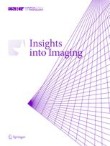Insights into Imaging is the official journal of the European Society of Radiology (ESR)
Liver imaging and pregnancy: what to expect when your patient is expecting
Liver diseases in pregnancy can be specific to gestation or only coincidental. In the latter case, the diagnosis can be difficult. Rapid diagnosis of maternal-fetal emergencies and situations requiring special...












































